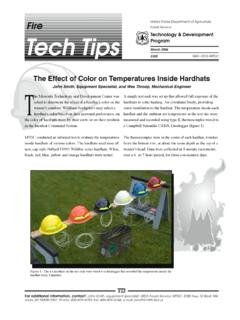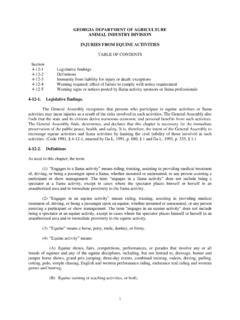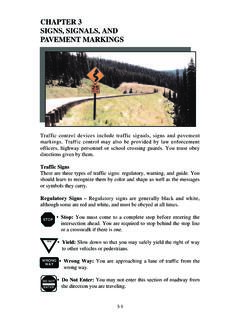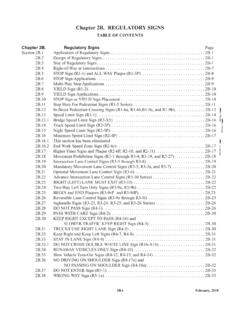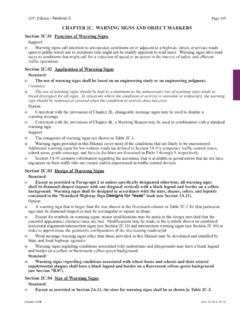Transcription of Chapter 4—Design Elements, Considerations, and Tools
1 4 1 Chapter 4 Design Elements, Considerations, and Tools Good low-water crossing design is a challenge because the objectives are to produce a structure that meets traffic needs, maintains the natural channel function, passes aquatic species, and is both safe and cost effective. Although each objective may be easy to achieve independently, some objectives can conflict, making it difficult to achieve all objectives at the same time. Poor site selection or choosing an inappropriate structure for a given site can exacerbate the problem. Like most hydraulic structures, low-water crossings require attention to both design detail, and compatibility with the hydrologic and natural setting into which the structure will go. Acknowledging Risk Low-water crossings inevitably involve some risk in several aspects of the selection and design process because they may allow people to drive through water, and because sites are commonly in rural areas with limited site and hydrologic information.
2 The following risk factors must be taken into consideration when using low-water crossings: Danger when people choose to drive through flooded fords. Occasional traffic delays during flooding making road use more restricted than anticipated. Exceeding the design flow, although fords are less sensitive to this factor than culverts or bridges. Possibility of damage to and failure of a structure, depending upon the type of structure selected, the scour protection used, riprap size chosen, etc. Environmental damage if the structure does not perform well. Although difficult to quantify, each risk can be kept at an acceptable level by applying thorough engineering design and good judgment, using good and suitable materials, and using an interdisciplinary process. Examining existing or current structures that are (or are not) performing well and taking a broad view of the stream and its function can significantly improve project judgment and help reduce the risk of problems.
3 Low-water crossings can be very cost effective structures when the attendant risks are controlled and minimized. If safety risks are determined to be unacceptably high, choose a different type of structure, such as a large culvert or bridge. On low-volume roads, the advantages of low-water crossings can outweigh their risks because traffic is low, speeds are slow, and a failed ford will likely cause less damage and cost less to replace than a failed culvert or 2 Low-Water Crossings Overview of Key Engineering Design Elements Key design elements of a low-water crossing, as identified in figures and , include the following: Accommodating traffic and passing the design vehicle safely. Planning for acceptable traffic delays with selection of appropriate low-flow and high-flow values. Ensuring the structure conforms to the site s shape, is as low as possible, and minimizes site disturbance and channel blockage.
4 Ensuring passage for aquatic organisms, when appropriate, by considering potential obstacles from structure height, changes in flow depth, or accelerated flow velocities. Maintaining the stability of the channel and banks by preventing scour around and beneath the structure, or by preventing bank erosion, sediment deposition, and potential changes in bedload size and quantity ( , maintaining channel form and function). Providing structure stability, including driving surface, elevated slabs, footings, approaches, and necessary armoring which prevents damage and minimizes maintenance. Armoring the structure s entire wetted perimeter, plus freeboard. Providing for traffic safety with warning signs , depth and object markers, curbs, etc. Disconnecting the road from the stream with appropriate surface drainage and roadway stabilization measures.
5 Poor structure design and site incompatibility can cause a variety of problems, including the following: Causing unreasonable traffic delays or difficulty turning around during flooding. Narrowing the channel, with resultant increase in flow velocity and scour. Damming the channel. (A relatively high structure can cause upstream sediment deposition and downstream scour or degradation, thereby changing the channel s shape). Restricting or blocking passage of fish or other aquatic organisms, as a result of high velocities and excessively high 3 Interrupting floodwater access to the flood plain adjacent to the active stream channel. Causing premature structure failure. Accidents and injury. The USDA Forest Service and other agencies have built many low-water crossings over the past 40 years. Many have worked and many have failed.
6 Most have required some maintenance or improvement to become the functioning structures seen today (see appendix A, case studies). Although functioning from an engineering and road-use standpoint, many low-water crossings are creating stream channel changes, accelerated maintenance needs, and fish barriers. The aquatic, geomorphic, and design perspectives that follow will help interdisciplinary teams design structures to serve road-user needs, minimize long-term costs, and protect the stream environment. Because many sites require considerable experience and judgment for proper structure selection and design, all information in this Chapter is based on both standard engineering road design practices and the experience and judgment of the authors. To accomplish the design objectives of a low-water crossing and have the crossing function well, it is important to evaluate and incorporate several fundamental elements involving channel, hydrologic, hydraulic, fisheries, and engineering considerations.
7 Subsequent sections address these elements in detail. Table summarizes these elements and their associated issues, as outlined below: Structure-Site Compatibility. Fish and Aquatic Organism Passage. Roadway and Site Geometry. Site Hydrology. Hydraulic Design. Scour, Bank Protection, and Preventing Channel Changes. Structural Design of the Driving Surface. Traffic Control and Safety. Materials Selection. Best Management Practices for Erosion Control and Water Quality 4 Design Elements, Considerations, and Tools4 4 Low-Water CrossingsFigure Perspective view of key design components for an unvented, improved low-water 5 Chapter 4 Design Elements, Considerations, and ToolsFigure Plan and cross section views of key design 6 Low-Water CrossingsTable Summary of key engineering design elements for low-water Compatibility: Select and design structures to maintain the function and bedload movement of the natural stream channel.
8 Conform to the natural channel shape and elevation where possible. Avoid damming the natural channel or adjacent flood plains. Keep the channel open. Do not cause significant aggradation in the channel upstream of the structure, or degradation or downcutting downstream of the structure. Do not confine or narrow bankfull flows. Do not increase the natural stream channel velocity. Accommodate major flood flows without significant drops in the water surface profile. Align structures perpendicular to the stream and Aquatic Organism Passage: Select structures that will pass all aquatic species, particularly fish, where needed and appropriate. For vented fords, open-bottom or embedded box culvert structures with a high VAR are often best. For simple fords, a roughened driving surface conforming to the grade and shape of the natural stream channel is best.
9 A low-water bridge may be the best solution. Maintain natural streambed substrate material, roughness, slope, and form through all or part of the structure. Avoid accelerating the velocity of streamflow, particularly at normal and low flows. Build a structure, with either single or multiple spans, that is at least as wide as the bankfull width of the natural channel. Provide areas of diverse flow velocity and depth. Maintain swimmable low-flow and Site Geometry: Build a structure that fits the site, with a vertical and horizontal alignment that will be safe and will allow the design vehicle to pass over the crossing. Select a site with a relatively straight road alignment. Locate a crossing at a straight reach of the stream. Conform to the natural dip of the channel as much as possible. Limit grades into the ford to 10 percent or less if possible.
10 Use a vertical curve dip through the ford, sufficiently gentle not to catch the bumper or undercarriage of vehicles passing through the ford. Provide enough space at both ends of the crossing for backing up and turnaround when Hydrology: Ideally use either a flow-duration or flood-frequency (peak discharge) design approach to specifically size the low-water crossing structure. Nonetheless, when site hydrologic conditions are unknown or difficult to determine, low-water crossings make a good structure choice. They can easily be designed to be overtopped by a large volume of water and/or debris, and they are not sensitive to the exact flow quantity. Determining the hydrologic properties of a site should be an interdisciplinary process, involving hydrologists and engineers. Determine the peak design flows (Q50 or Q100 events) to select the maximum size of the structure and identify maximum high-water level.







